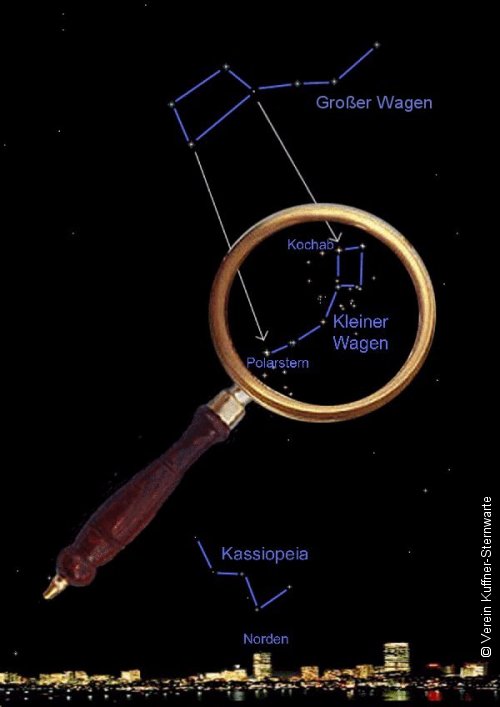1.
Look for an observing site under clear and moonless skies.
2. Compare the stars that you can see with the naked eye,
(without binoculars or a telescope, but using your glasses)
either in the Little Dipper
or in the constellation of Orion
to the respective small reference images below.
|

Present lunar phase
updated, 4 hourly
|
Finding Chart

Copyright:
Verein
Kuffner-Sternwarte
in case of non-private use please donate:
Die Erste, Vienna Austria, Blz: 20111,
Kto: 068 16223
|







These images show the constallation for different
degrees of artificial sky brightness. Click to enlarge.
|
ORION:
FINDING-CHARTS - PRINT AND OBSERVE!
|
HINTS AND INFORMATION
Avoid places with close direct illumination, e.g.
by streetlights. If you want to illuminate the
instructions use a red flashlight, or cover
the flashlight with your hand so that it
dimmly shines through it. Before observing you
should give your eyes time to
adapt to the dark. We encourage you to repeat
your observation at different days and different
times even at the same spot.
|
VISIBILITY
 On the northern hemisphere the LITTLE DIPPER is visible throughout the
entire year and the entire night. South of about 30 degree north (Arizona,
Spain, Turkey) it will approach the horizon. For people living in the southern
hemisphere it is invisible. The Little Dipper can be easily located using
the finding charts, but take into account that due to the Earth's rotation the
appearance of the sky changes continuously. The orientation of the
constellations is therefore not always
as shown on the images above. Depending on the actual season and time you will
notice a somewhat different appearance of the sky.
The Figure on the right tries to show that (click to enlarge).
With the help of the Big Dipperit is possible to locate the polar
star and hence the Little Dipper.
On the northern hemisphere the LITTLE DIPPER is visible throughout the
entire year and the entire night. South of about 30 degree north (Arizona,
Spain, Turkey) it will approach the horizon. For people living in the southern
hemisphere it is invisible. The Little Dipper can be easily located using
the finding charts, but take into account that due to the Earth's rotation the
appearance of the sky changes continuously. The orientation of the
constellations is therefore not always
as shown on the images above. Depending on the actual season and time you will
notice a somewhat different appearance of the sky.
The Figure on the right tries to show that (click to enlarge).
With the help of the Big Dipperit is possible to locate the polar
star and hence the Little Dipper.
The constellation of ORION is visible both from the
NORTHERN
and the SOUTHERN HEMISPHERE. The best time for observing Orion
is from early November to mid March. The precise rising and setting-times
depend on the specific observing spot. The appearence of Orion also
depends on the location. In the south its upside down (when compared to
its northern appearance).
STAR-CHART FOR BETTER ORIENTATION
On the
Sky and Telescope web-site you can find an excellent
interactive sky-chart (Java Applet), that displays a sky-chart after
selecting location, date and time. It can also be used to determine rising
and setting times of the constellations.
→ Interactive star-chart by Sky and Telescope
|
|